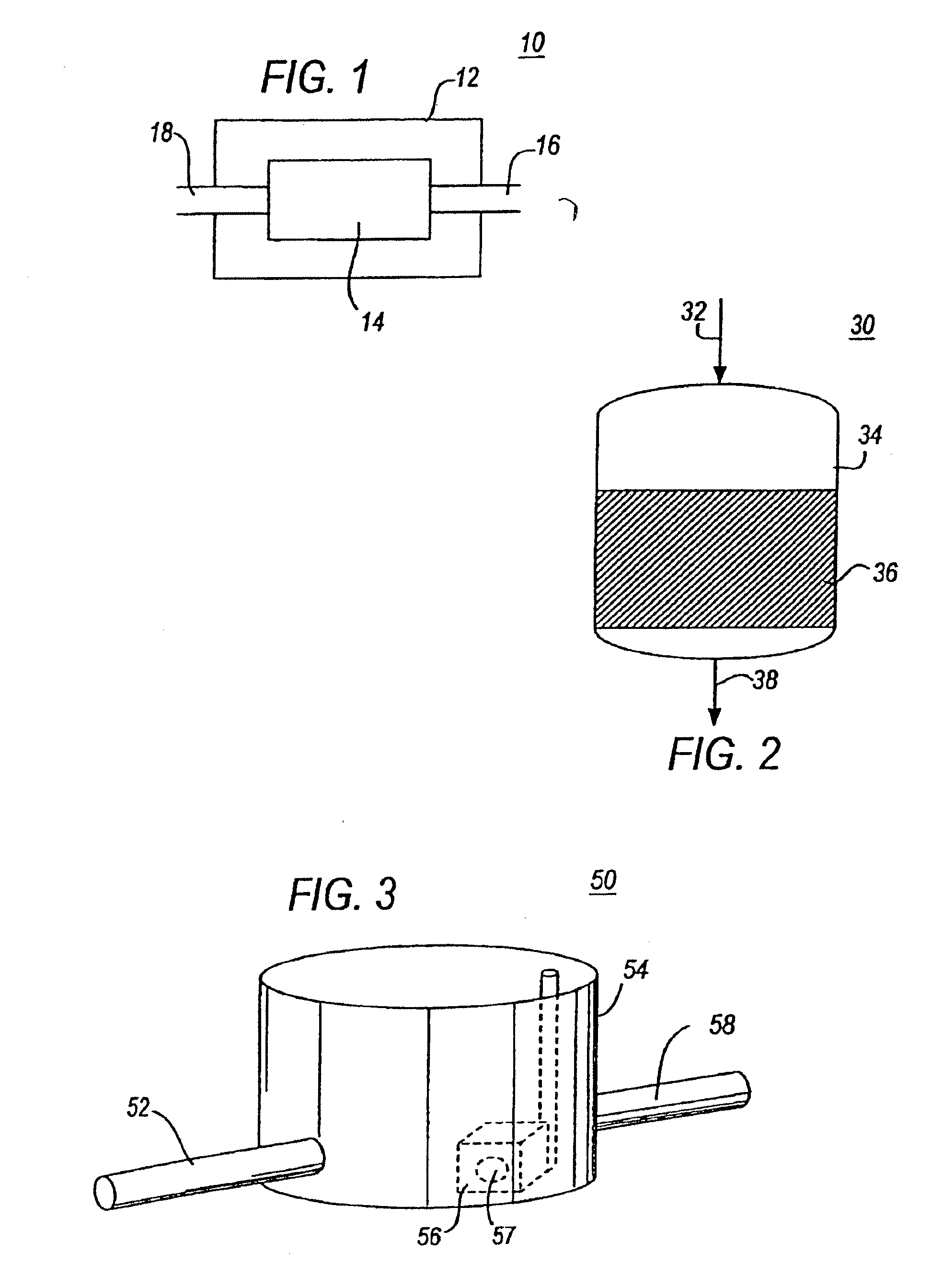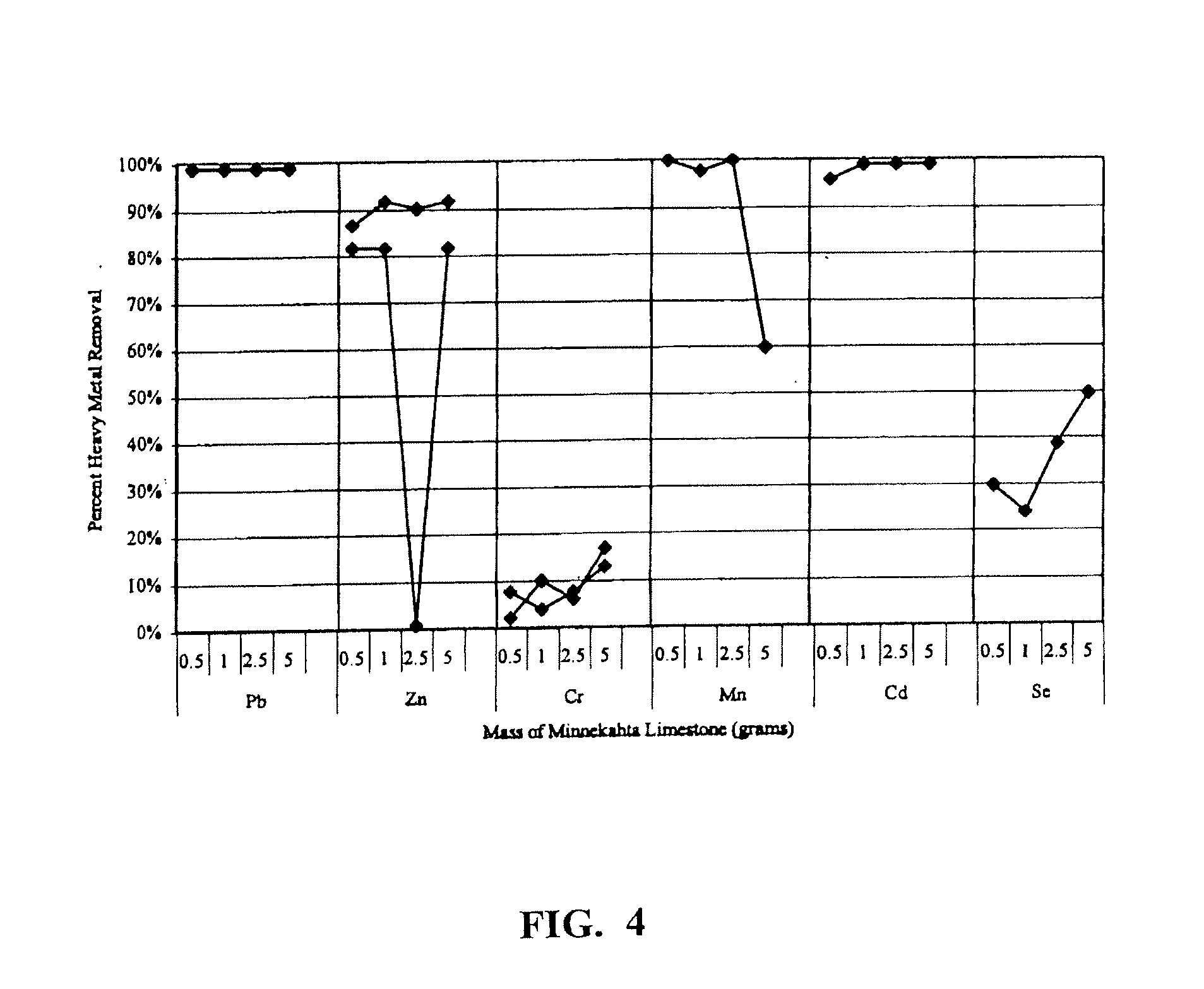Method and composition to reduce the amounts of heavy metal in aqueous solution
a technology of heavy metals and aqueous solutions, applied in the direction of water/sewage treatment by ion exchange, other chemical processes, separation processes, etc., can solve the problem of reducing the concentration of heavy metal contaminants in the aqueous solution, and achieve the effect of reducing the concentration
- Summary
- Abstract
- Description
- Claims
- Application Information
AI Technical Summary
Benefits of technology
Problems solved by technology
Method used
Image
Examples
examples
[0069]The efficiency of a sorption media of the present invention can be generally evaluated using either batch or column experiments. Batch experiments were conducted using Minnekahta or Kentucky Limestone as the primary limestone source. Other limestone units and additives to improve efficiency can also be tested as appropriate. The limestone was crushed using a roller crusher and then sieved to various size ranges. Samples of the limestone adsorbent were placed in labeled round-bottomed flasks. Samples were mixed with 100 mL of varying heavy metal solution concentrations (depending on the experiment). Heavy metal solutions were pH-balanced to a pH of 8 prior to mixing with the material sample. In addition, batch tests included a blank sample of 100 mL deionized water rather than heavy metal solution. Sample flasks were secured to a wrist shaker and agitated for 48 hours unless otherwise stated in the experiment description. After mixing, the samples were filtered with a 0.45 μm f...
example i
BET Surface Area Measurement
[0071]Specific surface area was analyzed using the Micromeritics Gemini III 2375 specific surface area analyzer. Batch experiments have shown that the smaller the limestone particle size, the greater the percent heavy metal removal per gram of limestone. As particle size decreases, the effective surface area per gram of the stationary phase increases. BET (Brunauer, Emmett, and Teller) specific surface area analysis was completed to determine the total surface area of the different materials. Table 2 is a summary of the BET specific surface area results for materials used in batch and which can be used column experiments.
[0072]BET results show that ball-milled limestone varies in surface area from about 0.8 m2 / g to about 4.6 m2 / g. Manufactured limestone granules composed of varying amounts of ball-milled Minnekahta Limestone, Portland cement binder, and magnesium carbonate have surface areas greater than ball-milled limestone. Granule surface areas ranged...
example ii
Particle Size Analysis
[0073]Particle size analysis on different types of limestone materials, reagent grade chemicals used as additives, and clay materials, was performed using the Microtrac Model S3000 Particle Size Analyzer. This instrument uses the phenomenon of scattered light from laser beams projected through a stream of suspended particles to measure particle size. The amount and direction of light scattered by the suspended particles were measured by an optical detector array and analyzed using Microtrac software. Results are reports as average particle size in microns.
TABLE 2Particle size measurementsAverage ParticleMaterial TypeSize (microns)Minnekahta Limestone (15.82Minnekahta Limestone (ball-milled on Apr. 14, 2003)6.66Minnekahta Limestone (ball-milled on Apr. 12, 2004)6.55Madison Limestone (15.23Madison Limestone (ball-milled)7.60Madison Dolomite (16.44Madison Dolomite (ball-milled)7.93Minnelusa Formation (13.95Minnelusa Formation (ball-milled)9.08Kentucky Limestone (b...
PUM
| Property | Measurement | Unit |
|---|---|---|
| Percent by mass | aaaaa | aaaaa |
| Percent by mass | aaaaa | aaaaa |
| Percent by mass | aaaaa | aaaaa |
Abstract
Description
Claims
Application Information
 Login to View More
Login to View More - R&D
- Intellectual Property
- Life Sciences
- Materials
- Tech Scout
- Unparalleled Data Quality
- Higher Quality Content
- 60% Fewer Hallucinations
Browse by: Latest US Patents, China's latest patents, Technical Efficacy Thesaurus, Application Domain, Technology Topic, Popular Technical Reports.
© 2025 PatSnap. All rights reserved.Legal|Privacy policy|Modern Slavery Act Transparency Statement|Sitemap|About US| Contact US: help@patsnap.com



